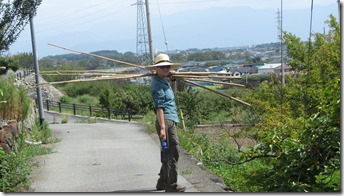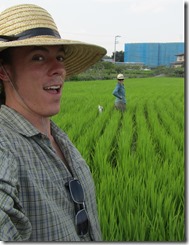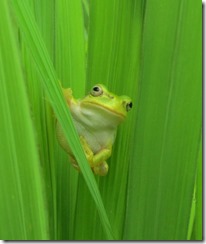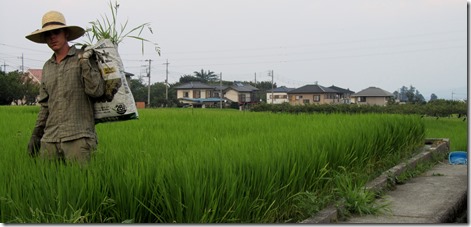Paddy Full of Rice
 About 1 week ago we stepped into a rice paddy and out of the jet lag daze that we have been in. From the exciting streets of Tokyo, where there was something new around every corner and more, we took the local trains to Kanda’s Natural Farm in the Yamanashi Prefecture, aka countryside. Very few travelers make it to rural Japan and as we rolled further from the heart of Tokyo we saw and heard less English, it became more difficult to navigate through the train terminals to get to the connecting train, but with the help of locals and some perseverance we found ourselves at our stop. We fo
About 1 week ago we stepped into a rice paddy and out of the jet lag daze that we have been in. From the exciting streets of Tokyo, where there was something new around every corner and more, we took the local trains to Kanda’s Natural Farm in the Yamanashi Prefecture, aka countryside. Very few travelers make it to rural Japan and as we rolled further from the heart of Tokyo we saw and heard less English, it became more difficult to navigate through the train terminals to get to the connecting train, but with the help of locals and some perseverance we found ourselves at our stop. We fo und a pay phone and called Kanda himself to pick us up. The next day we followed Kanda, a long-haired man with a gentle smile and always a towel or two wrapped around his head, into a rice paddy. Our job was to rid the paddy of 2 types of weeds. The bottom and roots of the rice sit in water until harvest time which is at the start of October. For more years than not people have grown and weeded rice paddies bare foot. We wore rain boot and the classic wide brimmed hat (see pictures). Walking in a rice paddy is not so easy and at first I thought I would fall for sure which I would hate to do, since the rows were so tight and crushing rice that is just getting ready to bloom would be disastrous on our first day! We slipped and fumbled and tried not to push the rice which were in grass like bunches, the leaves are very sharp so we wore long sleeves and gloves. Kanda squared us away and left to do other tasks. There we were in 1 of many rice paddies in a neighborhood surrounded by lush mountains. Due to the swelter, the scorching heat that is surrounding me even as I write this,
und a pay phone and called Kanda himself to pick us up. The next day we followed Kanda, a long-haired man with a gentle smile and always a towel or two wrapped around his head, into a rice paddy. Our job was to rid the paddy of 2 types of weeds. The bottom and roots of the rice sit in water until harvest time which is at the start of October. For more years than not people have grown and weeded rice paddies bare foot. We wore rain boot and the classic wide brimmed hat (see pictures). Walking in a rice paddy is not so easy and at first I thought I would fall for sure which I would hate to do, since the rows were so tight and crushing rice that is just getting ready to bloom would be disastrous on our first day! We slipped and fumbled and tried not to push the rice which were in grass like bunches, the leaves are very sharp so we wore long sleeves and gloves. Kanda squared us away and left to do other tasks. There we were in 1 of many rice paddies in a neighborhood surrounded by lush mountains. Due to the swelter, the scorching heat that is surrounding me even as I write this,  we work from 8-11 and then take a break from 11-3 and go back in the afternoon for 3 more hours. This is the best; we escape the extreme heat of the day, but don’t worry we get a good dose of it. When we arrived we joined the ranks with 2 other WWOOFers (volunteers on organic farms): Chloe from Australia and Margot from Austria. They both helped us with the language barrier and became our Japanese teachers. We worked for 2 days in the rice paddies before the O-Bon festival began. Nobody works during this holiday which celebrates the family ancestors and everyone returns to their hometown for 3 days. The weeding of the rice was finished as well since the plants are too delicate to handle trampling over the roots. Being the nature lover that I am I loved the creatures we would find among the micro ecosystem of the paddies. Little green frogs everywhere (once a local man walked by and there was a little green frog perched on the nape of his neck…glorious!) praying mantis, grasshoppers, caterpillars, and vibrant blue, white, brown and orange dragonflies and more. After 3 days off and a camping trip with Chloe and Margot (we will tell you more about that) we got back to work and this time Andy and I were in charge of putting fencing around all of Kanda’s rice paddies to protect the budding rice from the birds. Rice is a grass and we eat the seeds when the flowers bloom the husk will open and the plant releases the seeds which we eat. The plant gets heavy with seeds and slumps over the edge of the rice paddy and birds take the opportunity to munch on it. So we hammer in stakes around the paddy, string up fishing line in two rows to hold the weeping rice and
we work from 8-11 and then take a break from 11-3 and go back in the afternoon for 3 more hours. This is the best; we escape the extreme heat of the day, but don’t worry we get a good dose of it. When we arrived we joined the ranks with 2 other WWOOFers (volunteers on organic farms): Chloe from Australia and Margot from Austria. They both helped us with the language barrier and became our Japanese teachers. We worked for 2 days in the rice paddies before the O-Bon festival began. Nobody works during this holiday which celebrates the family ancestors and everyone returns to their hometown for 3 days. The weeding of the rice was finished as well since the plants are too delicate to handle trampling over the roots. Being the nature lover that I am I loved the creatures we would find among the micro ecosystem of the paddies. Little green frogs everywhere (once a local man walked by and there was a little green frog perched on the nape of his neck…glorious!) praying mantis, grasshoppers, caterpillars, and vibrant blue, white, brown and orange dragonflies and more. After 3 days off and a camping trip with Chloe and Margot (we will tell you more about that) we got back to work and this time Andy and I were in charge of putting fencing around all of Kanda’s rice paddies to protect the budding rice from the birds. Rice is a grass and we eat the seeds when the flowers bloom the husk will open and the plant releases the seeds which we eat. The plant gets heavy with seeds and slumps over the edge of the rice paddy and birds take the opportunity to munch on it. So we hammer in stakes around the paddy, string up fishing line in two rows to hold the weeping rice and  then tie on flashy tape to scare the birds away. We learned the way to tie and tighten the lines and we have completed almost 20 fields. We have learned, not all rice paddies are the same they are different shapes and sizes and fencing them in can be hazardous with the maze of concrete water drainages and weeds. I took a spill when I stepped down into what I thought was solid ground, but was actually a concrete ditch. Don’t worry when we were stringing the fence on a 6 foot ledge neither of us fell! Yesterday we had a break from the stake making and line stringing as Kanda needed us to fix the net around the millet fields. Yes there is a net over the entire field and it was our job to drive the stakes into the ground to hold the net away from the millet plants; millet it a nice snack for birds too. In the jungle of millet we realized the ground was very hard and the long bamboo stakes were not going into the ground and the next gusty wind would just blow it over. Birds would win. Andy, being innovative found a solution by using bigger bamboo and driving that into the ground and then placing the stake in that to hold the net. Kanda wasn’t sure what Andy was doing but gave him the freedom to try it. It ended up working very well and the net looks much better. I felt a high amount of frustration with the project, not sure if it was the jungle of millet crowding me or the insane net that would get caught on everything, especially buttons! We can see the net from our dome house and it does feel gratifying to know we improved it. Birds won’t win for now. Well, that’s a bit about our work here. We (Andy’s turn) will write more about camping, food, and other adventures of Japan.
then tie on flashy tape to scare the birds away. We learned the way to tie and tighten the lines and we have completed almost 20 fields. We have learned, not all rice paddies are the same they are different shapes and sizes and fencing them in can be hazardous with the maze of concrete water drainages and weeds. I took a spill when I stepped down into what I thought was solid ground, but was actually a concrete ditch. Don’t worry when we were stringing the fence on a 6 foot ledge neither of us fell! Yesterday we had a break from the stake making and line stringing as Kanda needed us to fix the net around the millet fields. Yes there is a net over the entire field and it was our job to drive the stakes into the ground to hold the net away from the millet plants; millet it a nice snack for birds too. In the jungle of millet we realized the ground was very hard and the long bamboo stakes were not going into the ground and the next gusty wind would just blow it over. Birds would win. Andy, being innovative found a solution by using bigger bamboo and driving that into the ground and then placing the stake in that to hold the net. Kanda wasn’t sure what Andy was doing but gave him the freedom to try it. It ended up working very well and the net looks much better. I felt a high amount of frustration with the project, not sure if it was the jungle of millet crowding me or the insane net that would get caught on everything, especially buttons! We can see the net from our dome house and it does feel gratifying to know we improved it. Birds won’t win for now. Well, that’s a bit about our work here. We (Andy’s turn) will write more about camping, food, and other adventures of Japan.
 We travel: to learn and grow, to challenge ourselves, stretch our limits and foster an appreciation of both the world at large and our own back home.
We travel: to learn and grow, to challenge ourselves, stretch our limits and foster an appreciation of both the world at large and our own back home.


